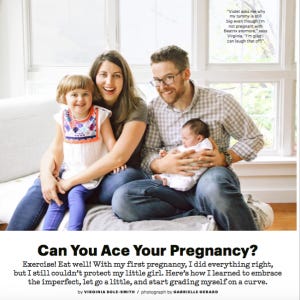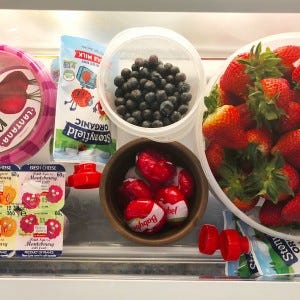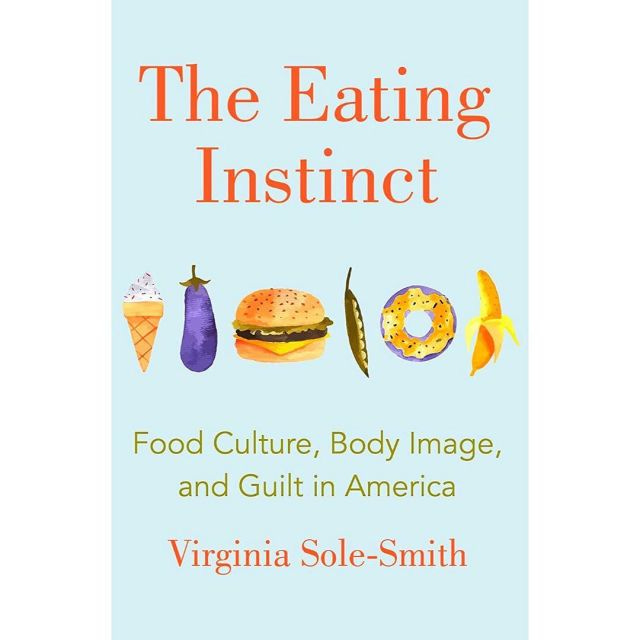The Perfect Pregnancy Fallacy, Snack Struggles & Good Food Reads

It was the 18th week of my second pregnancy. I lay in a fake-leather recliner, holding my breath and my husband’s hand as a maternal fetal medicine specialist slid an ultrasound wand over my abdomen. This wasn’t your standard anatomy check. The doctor was trying to see if our baby had all four chambers of her heart. And if she would be spared the 12 surgeries, six months of hospital life, and countless moments of pain and panic that our first daughter endured during her early years.
Violet was born with a rare collection of life-threatening congenital heart defects, all of which were somehow missed on the half-dozen ultrasounds I had during my pregnancy with her. We didn't know anything was wrong until her heart began shutting down when she was a month old. Violet is now a happy and healthy 4-year-old who begins every sentence with "Actually..." But her heart condition is lifelong. The question that haunted every conversation Dan and I had about a second child was: What if it happens again?
The odds of that were small, but much bigger than if it hadn’t happened the first time. So my second pregnancy was immediately classified as high risk. I underwent every genetic test and screening because my doctor was determined not to miss so much as a prenatal pimple. And so, after searching the grainy images of our baby on the ultrasound monitor for about ten minutes, my doctor turned to me with a huge smile. “Her heart is developing normally,” he said. “This baby gets an A+. Good work, Mom!”
I cried, of course. Until that moment, I hadn’t trusted myself to build a healthy baby heart. After all, the only other time I tried, I’d failed pretty spectacularly. That’s how it felt the day they diagnosed Violet’s heart condition. And now, with his horrible compliment, this doctor had confirmed it: If this baby was getting an A+, then that must mean I had flunked my first pregnancy.
Read the rest of my essay on our obsession with pregnancy perfection (from the April 2018 issue of Parents) here.
(Photo by Gabrielle Gerard Photography.)

I posted this pic on Instagram a few weeks ago, of my effort to give our 4-year-old choices she would enjoy (rather than whine about) at snack time. The goal here was not to police her sugar intake or anything like that, but rather, to get on top of the endless “I need a snack!”-itis that we sometimes (often) endure. A lot of folks chimed in, because whoa, the snack struggle is real. It’s such a weird invented meal, stemming partly from legit need (kid bellies do need filling every few hours and often more frequently than adults) but partly from our snack-on-demand food culture, that encourages kids to think they need to eat whenever their hands aren’t busy. Click here for an update on how the snack drawer strategy worked for us — what it fixed, and what it didn't.
PS. Here are a few other good food reads, if you're in the mood...
What do children understand about food insecurity? Eleven-year-old Avery “helped” by forgoing snacks and by drinking water to feel full.
And by the way, 36 percent of college students don’t have enough to eat.
Eating unhealthy food is not a character flaw. (I’m also really excited to read her new book, The Food Therapist.)
Rebecca Scritchfield on why our fear of sugar may be more toxic than sugar itself.

Book Report
I spent most of the last month wading through a ton of final edits on the manuscript — notes from our copy editor, notes from my fact-checker, notes from the publisher's lawyer. So many notes! But all so important to make sure the book is as good — and as accurate! — as it can possibly be. It's now headed into production and I should have what we call "first pass pages" in the next few weeks. In the meantime, you can, of course, preorder the book.
And if you're on Instagram, feel free to weigh in on my author photo pic — plus, why is it that women writers always smile in headshots, but male writers rarely do? (Check out "Author Photo" in my saved Instastories for the full debate.)
And, as always, thank you for forwarding, sharing and subscribing.



